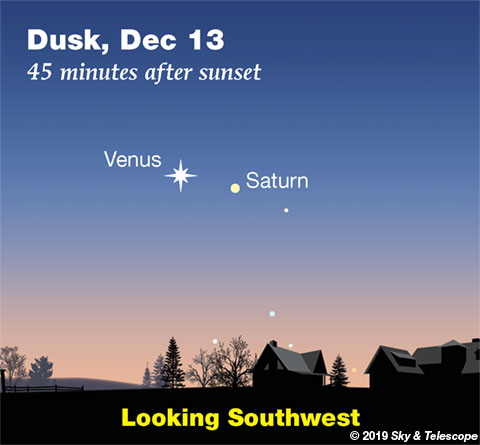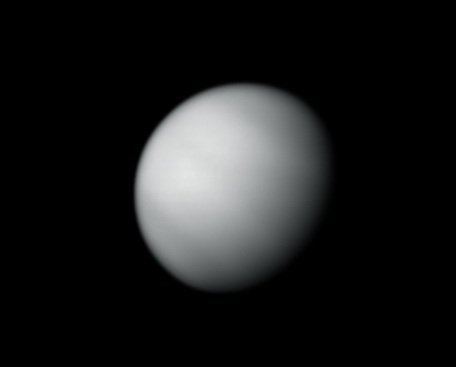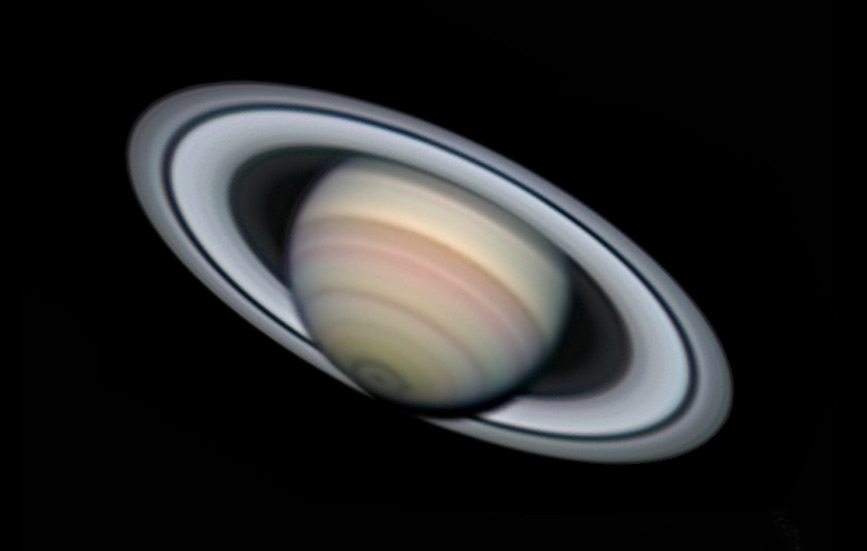
Friday, Dec. 13
• How soon after you spot Venus in twilight can you first catch tiny Saturn glimmering to its right? This evening they're 3½° apart.
• The Geminid Meteor shower, usually one of the best of the year, should be at its peak late tonight and late tomorrow night. But the waning gibbous Moon will light the sky both nights, so only the brightest meteors will shine through. You might see one every several minutes on average from midnight to dawn, if you have a wide-open view of the sky overhead and shield the glary Moon from your eyes.
In early evening the meteors will be much fewer, but the Moon will be lower — and the Geminids that do appear will be long Earth-grazers skimming far across the top of the atmosphere.
You can watch the activity profile of this year's shower take shape on the International Meteor Organization's live activity graph, as meteor counters worldwide, using standardized methods, report their results.
Saturday, Dec. 14
• The waning gibbous Moon, in Gemini, rises after dinnertime underneath Pollux and Castor. To the Moon's lower right, Procyon soon appears.
Off to the right of Gemini sparkles Orion. High above Orion shines orange Aldebaran, and above Aldebaran are the Pleiades.
Far left of Aldebaran and the Pleiades shines Capella.
Below Orion, brilliant Sirius rises around 8.
Sunday, Dec. 15
• The little Pleiades cluster shines high in the southeast after dinnertime (over Orion and Aldebaran) no bigger than your fingertip at arm's length. How many Pleiads can you count with your unaided eye? Take your time and keep looking. Most people can count 6. With sharp eyesight, a good dark sky, and a steady gaze, you may be able to make out 8 or 9.
Monday, Dec. 16
• After the waning Moon rises late this evening (by about 11 p.m.), look for Regulus just a few degrees to its right. The slightly fainter star on the other side of the Moon is Algieba.
Tuesday, Dec. 17
• The Summer Triangle is sinking lower in the west, and Altair is the first of its stars to go (for mid-northern skywatchers). Start by spotting bright Vega, magnitude zero, in the northwest after dark. The brightest star above Vega is Deneb. Altair, the Triangle's third star, is farther to Vega's left or lower left. How late into the night, and into the advancing season, can you keep Altair in view?
Wednesday, Dec. 18
• Last-quarter Moon (exact at 11:57 p.m. EST). The Moon rises around midnight tonight, shining in the head of Virgo under Leo.
Thursday, Dec. 19
• With the Moon out of the evening sky, explore the deep-sky sights of Aries and Pisces high in the south with the Deep-Sky Wonders article, chart and photos in the December Sky & Telescope, page 54.
Friday, Dec. 20
• Have you ever watched a Sirius-rise? Find an open view right down to the east-southeast horizon, and watch for Sirius to come up about two fists at arm's length below Orion's vertical Belt. This will happen sometime around 8 p.m., depending on your location.
When a star is very low, it tends to twinkle quite slowly and often in vivid colors. Sirius is bright enough to show these effects well, especially with binoculars.
Saturday, Dec. 21
• This is the time of year when M31, the Andromeda Galaxy, passes your zenith shortly after dark (if you live in the mid-northern latitudes). The exact time depends on your longitude. Binoculars will show M31 just off the knee of the Andromeda constellation's stick figure; see the big evening constellation chart in the center of Sky & Telescope.
• Tonight is the longest night of the year in the Northern Hemisphere; the shortest night in the Southern Hemisphere. The solstice occurs at 11:19 p.m. EST (8:19 p.m. PST), marking the start of northern winter, when the Sun begins its six-month return northward in the sky of Earth.
________________________
Want to become a better astronomer? Learn your way around the constellations. They're the key to locating everything fainter and deeper to hunt with binoculars or a telescope.
This is an outdoor nature hobby. For an easy-to-use constellation guide covering the whole evening sky, use the big monthly map in the center of each issue of Sky & Telescope, the essential guide to astronomy.

Once you get a telescope, to put it to good use you'll need a detailed, large-scale sky atlas (set of charts). The basic standard is the Pocket Sky Atlas (in either the original or Jumbo Edition), which shows stars to magnitude 7.6.
Next up is the larger and deeper Sky Atlas 2000.0, plotting stars to magnitude 8.5; nearly three times as many. The next up, once you know your way around, are the even larger Interstellarum atlas (stars to magnitude 9.5) and Uranometria 2000.0 (stars to magnitude 9.75). And read how to use sky charts with a telescope.
You'll also want a good deep-sky guidebook, such as Sue French's Deep-Sky Wonders collection (which includes its own charts), Sky Atlas 2000.0 Companion by Strong and Sinnott, or the bigger Night Sky Observer's Guide by Kepple and Sanner.
Can a computerized telescope replace charts? Not for beginners, I don't think, and not on mounts and tripods that are less than top-quality mechanically (meaning really heavy and expensive). And as Terence Dickinson and Alan Dyer say in their Backyard Astronomer's Guide, "A full appreciation of the universe cannot come without developing the skills to find things in the sky and understanding how the sky works. This knowledge comes only by spending time under the stars with star maps in hand."
This Week's Planet Roundup
Mercury is still a bright magnitude –0.6, but it's sinking low into the sunrise glow. Look for it early in the week just above the the east-southeast horizon about 30 minutes before sunup. Bring binoculars. Don't be confused by fainter Antares twinkling in the vicinity. Mercury is well to the lower left of fainter Mars.

Venus (magnitude –3.9) shines in the southwest in evening twilight, a little higher each week. It's on its way up to a grand, high "Evening Star" apparition all winter and into the spring. In a telescope it's small (12 arcseconds in diameter) and gibbous, since it's nearly on the far side of the Sun from us.
Mars (magnitude +1.7, in Libra) is low in the east-southeast in early dawn, far below Arcturus and less far lower left of Spica (and upper right of very low Mercury). Mars is on the far side of the Sun from us and is a very tiny 4 arcseconds in apparent diameter.
Jupiter is lost in the sunset.

Uranus (magnitude 5.7, in southern Aries) and Neptune (magnitude 7.9, in eastern Aquarius) stand high in the south and south-southwest, respectively, right after dark. Use our finder charts for Uranus and Neptune.
All descriptions that relate to your horizon — including the words up, down, right, and left — are written for the world's mid-northern latitudes. Descriptions that also depend on longitude (mainly Moon positions) are for North America.
Eastern Standard Time (EST) is Universal Time (UT, UTC, GMT, or Z time) minus 5 hours.
![]() Audio sky tour. Out under the evening sky with your earbuds in place, listen to Kelly Beatty's monthly podcast tour of the heavens above. It's free.
Audio sky tour. Out under the evening sky with your earbuds in place, listen to Kelly Beatty's monthly podcast tour of the heavens above. It's free.
 0
0








Comments
You must be logged in to post a comment.